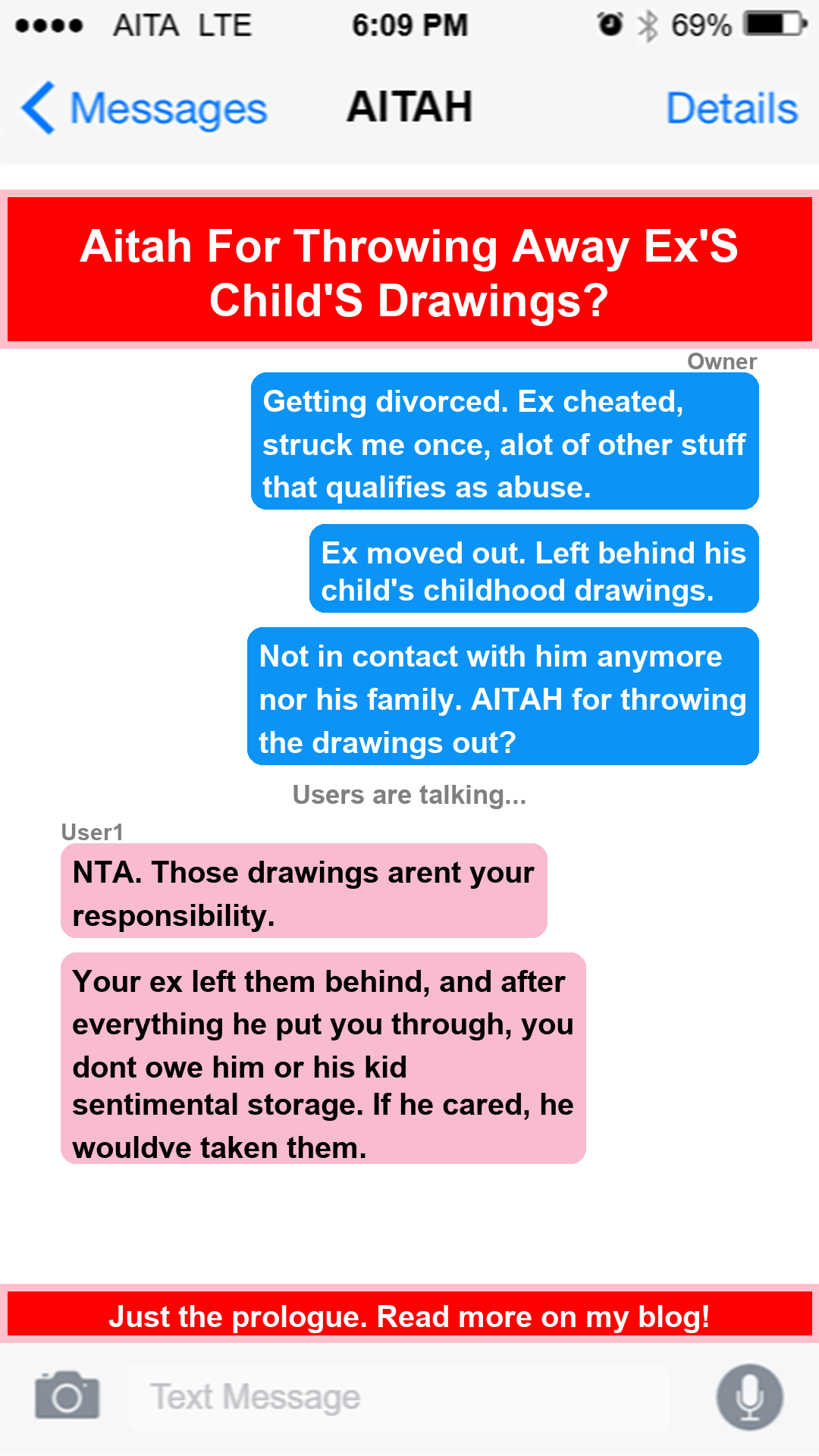AITAH for throwing away ex’s child’s drawings?
 Image credit: Pixabay (This is example image – Not the actual photo)
Image credit: Pixabay (This is example image – Not the actual photo)
AITA for Disposing of My Ex’s Child’s Drawings?
After enduring a tumultuous marriage filled with infidelity and abuse, a woman finds herself navigating the emotional aftermath of her divorce. When her ex-husband moves out, he leaves behind his child’s cherished drawings, but she grapples with whether to keep them or let them go. This dilemma raises questions about the ties that bind us to our past and the impact of toxic relationships on our lives. Many can relate to the struggle of letting go of remnants from a painful chapter while seeking closure and healing.
Am I the Asshole for Disposing of My Ex’s Child’s Drawings?
In a situation filled with family drama and emotional turmoil, a woman reflects on her decision to throw out her ex-partner’s child’s childhood drawings. Here’s a breakdown of the events leading up to this conflict:
- Background: The woman is currently going through a divorce due to her ex-partner’s infidelity and abusive behavior, which included physical violence.
- Separation: After the separation, the ex-partner moved out of their shared home, leaving behind various personal items, including the child’s drawings.
- No Contact: Since the separation, the woman has had no contact with her ex-partner or his family, further complicating the emotional landscape.
Faced with the remnants of a relationship that has caused her significant pain, she made the decision to dispose of the drawings. Here are the reasons she considered:
- Emotional Weight: The drawings served as a constant reminder of the relationship and the trauma associated with it.
- Closure: Disposing of the drawings was seen as a step towards moving on and finding closure after a tumultuous period.
- Conflict Resolution: The woman felt that keeping the drawings would only prolong the emotional conflict she was experiencing.
However, she is now questioning whether her actions were justified. Here are the points of contention:
- Child’s Sentiment: The drawings may hold sentimental value for the child, raising questions about whether the woman should have considered the child’s feelings before disposing of them.
- Ex-Partner’s Reaction: If her ex-partner were to find out, it could lead to further conflict and tension, especially given the already strained relationship.
- Future Implications: The decision could impact her relationship with the child in the future, should they ever reconnect.
In light of these considerations, the woman is left wondering if she is the asshole for throwing out the drawings. The situation highlights the complexities of family dynamics, especially in the context of divorce and emotional healing. As she navigates this challenging period, she seeks clarity on whether her actions were justified or if they crossed a line.
This is Original story from Reddit
 Image credit: Pixabay (This is example image – Not the actual photo)
Image credit: Pixabay (This is example image – Not the actual photo)
Story: Getting Divorced
Ex cheated, struck me once, and a lot of other stuff that qualifies as abuse. Ex moved out and left behind his child’s childhood drawings. I am not in contact with him anymore, nor his family.
AITAH for throwing the drawings out?
View the Original Reddit Post Here
Summary of Reddit Comments
The top Reddit comments reveal a strong consensus around NTA due to the belief that the drawings left behind by the ex are not the commenter’s responsibility and that they have the right to move on. Most users agree that the ex should have taken the items if they were important, highlighting the overall moral takeaway that one should not be burdened by the remnants of a past relationship.
- Verdict: NTA
Expert Advice for Resolving the Conflict
In navigating the complexities of relationships, especially after a divorce, it’s essential to approach conflicts with empathy and understanding. Here are some practical steps for both the woman and her ex-partner to consider in resolving this situation:
For the Woman:
- Reflect on Emotions: Acknowledge the emotional weight of the drawings and how they relate to your healing process. It’s important to validate your feelings while also considering the child’s perspective.
- Communicate Openly: If possible, reach out to your ex-partner to discuss the situation. Express your feelings about the drawings and your reasons for disposing of them. This can help clear the air and prevent misunderstandings.
- Consider the Child’s Feelings: If you have the opportunity, think about how the child might feel about the drawings. If you can, offer to create new memories or art together in the future, which can help foster a positive relationship.
- Seek Closure in Other Ways: Find alternative methods to achieve closure that do not involve the child’s belongings. This could include therapy, journaling, or engaging in new hobbies that promote healing.
For the Ex-Partner:
- Understand the Context: Recognize that the woman is going through a difficult time and that her actions may stem from her need for closure. Approach the situation with empathy rather than anger.
- Communicate with Compassion: If you feel hurt by the disposal of the drawings, express your feelings calmly and respectfully. This can help facilitate a constructive conversation rather than escalating tensions.
- Focus on the Child’s Well-Being: Prioritize the child’s emotional needs. If the drawings were significant to the child, consider how to address this with them in a supportive manner.
- Take Responsibility: Reflect on your role in the relationship and the separation. Acknowledge that if the drawings were important, you should have taken them when you moved out.
Moving Forward:
Both parties should aim to foster a respectful and understanding relationship, especially if children are involved. Here are some additional steps to consider:
- Establish Boundaries: Set clear boundaries regarding communication and shared responsibilities to avoid future conflicts.
- Consider Mediation: If direct communication proves difficult, consider involving a neutral third party to help facilitate discussions and resolve lingering issues.
- Focus on Healing: Both individuals should prioritize their emotional well-being and healing. Engaging in self-care practices can help mitigate feelings of resentment and anger.
Ultimately, navigating the aftermath of a relationship requires patience, understanding, and a willingness to communicate openly. By addressing the situation with empathy, both parties can work towards a resolution that respects their feelings and the child’s emotional needs.
Join the Discussion
 Image credit: Pixabay (This is example image – Not the actual photo)
Image credit: Pixabay (This is example image – Not the actual photo)
What do you think? Would you have handled this differently?
Share your thoughts below! Vote: Do you agree with Reddit’s verdict?

